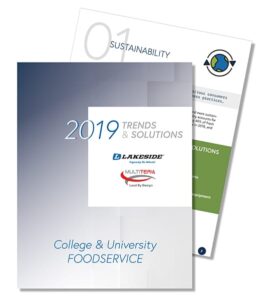
Sustainability is not only popular amongst today’s college-aged students; it’s also an easy way to save money.
Sustainability is often seen as being more complicated than it really is. Bottom line, the less we waste, the more we save. That goes for our reputations as well as our wallets.
More than ever, younger demographics of students are interested in foodservice that’s not just good for their bodies. They’re looking for foodservice that’s good for the environment as well. A trip across campus at your old alma mater may look the same in some ways, but step into the student union dining hall and it might look totally different.
Today, colleges and universities have a wide range of foodservice delivery components. When properly combined, they can produce a process that helps create a more sustainable foodservice program. The University of Michigan is a great example. Their foodservice department is actively incorporating various sustainable practices with the goal to become carbon-neutral in 10 years.
While it’s great to set the bar really high like this, it requires extensive planning and a great deal of patience to work a 10-year plan. However, there’s always some low-hanging fruit that’s ripe for the taking and easy to grab too. Here are some practical tips that you can immediately implement to help your college and university foodservice department become more sustainable right away:
FOOD WASTE
Food waste is by far one of the most important foodservice trends of 2019. As Americans, we waste roughly 40 percent of our entire food supply, and this is no different on our college campuses. Students are leading the way on many of these initiatives. Some prime areas to begin exploring college foodservice sustainability include programs that use sophisticated menu management systems to assist in forecasting, purchasing and production. Some software even measures and monitors food waste production in the dish room. Check out these food waste reduction resources from the Environmental Protection Agency for more ideas.
BUYING LOCAL
Many college and university operators buy local for many sustainable reasons, often to decrease the distances required to transport food. Trucking and shipping not only add a layer of cost to ingredients, but they also add carbon to our atmosphere. More than ever in the history of college and university foodservice, operators are sourcing ingredients closer to campus from local farmers, ranchers and artisans, and in some cases, ingredients are grown or raised on campus.
CLEAN INGREDIENTS
Foods grown sustainably are often organic which means they’re almost always antibiotic-free, hormone-free, and pesticide-free. Are there additional costs associated with better, cleaner ingredients? Of course, but students are driving these demands and they’re also willing to pay the difference when they know they’re helping contribute to sustainable efforts.
“When budgets are tight or there are pressures to raise revenues or save costs, it’s best to start with menu engineering,” says Shawn LaPean, a food consultant at Blendid, a manufacturer of autonomous robotic kiosks that prepare and serve custom blended beverages. “For instance, instead of serving a 4 ounce burger, consider serving a 3 ounce burger to ensure you maintain a perception of value, whether you manage an ‘all-you-can-eat’ or a cash operation.” Shawn further states that changing the portions slightly without lowering the value sometimes enables operators to afford to include sustainable and organic products on their menus instead of conventional products. He also says that “sustainable and organic products from local suppliers is of primary importance to customers.”
UTILITIES & FACILITIES
The fourth main component to sustainability involves the amounts of utilities it takes to complete a service. Operators are looking to continuously improve the efficiency of every aspect of their operations – from water and gas, to electricity and refrigerant, the quantities you use impact the world as well as your wallet.
Foodservice is one of the largest consumers of energy over any other type of operation, and that’s why foodservice equipment and supplies are so critical in reducing usage levels of our valuable resources. From on-demand ventilation, to energy-efficient blenders, a serious examination of the equipment used in a college or university kitchen can help reduce utility bills. There are many other ideas like these detailed in an article in Community College Daily.
Sustainability is an important college and university foodservice trend. Would you like to learn about more relevant trends? Download our free College & University Trends Guide to see the other trends impacting our industry.
Lakeside and Multiteria have researched 7 foodservice trends that will be important to colleges and universities in the 2019-2020 school year. Download your free copy of this quick resource guide today to stay on top of the latest ideas and innovations that will help you maintain a first-class foodservice operation!

